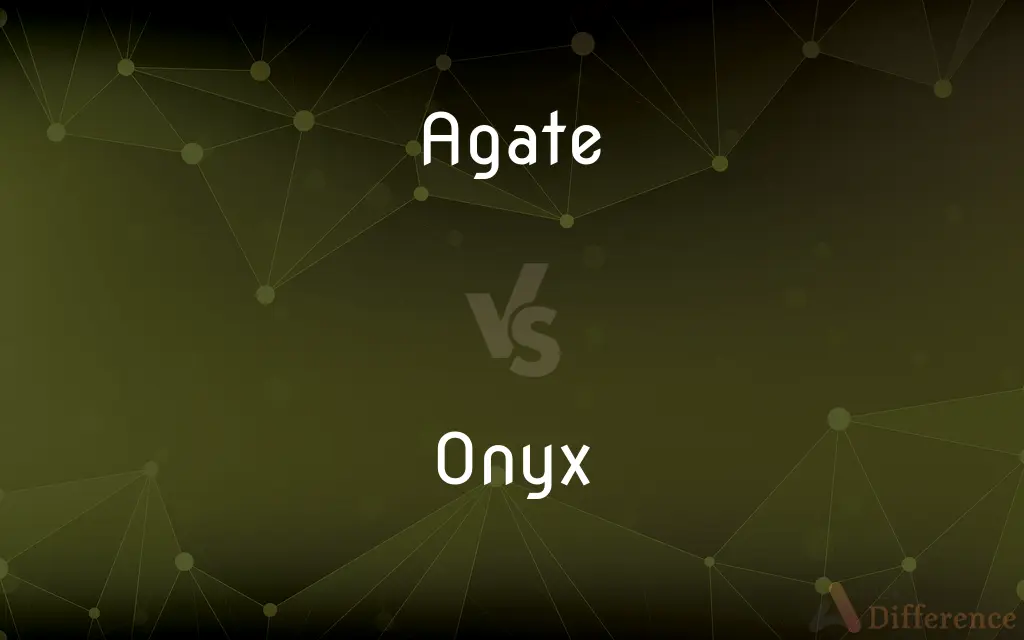Agate vs. Onyx — What's the Difference?
By Fiza Rafique & Urooj Arif — Updated on March 25, 2024
Agate is a banded, colorful form of chalcedony, known for its variety and use in decorative items and jewelry, while onyx features parallel bands, usually in black and white, and is valued for its bold, contrasting appearance in fine jewelry and carvings.

Difference Between Agate and Onyx
Table of Contents
ADVERTISEMENT
Key Differences
Agate is a variety of chalcedony that comes in a wide range of colors and patterns, often used in jewelry and ornamental objects for its aesthetic appeal. On the other hand, onyx is a type of chalcedony characterized by its distinctive parallel banding, typically showcasing black and white layers, and is frequently used in jewelry and decorative items for its striking appearance.
The formation process of agate involves the filling of cavities in volcanic rocks or ancient lavas, where layers of silica cool and crystallize, resulting in its unique banded patterns. Whereas, onyx forms from the deposition of silica in cold water solutions, often in caves, leading to its straight, parallel bands.
Agate is prized for its translucency and variety of colors, including reds, greens, yellows, and blues, making each piece unique. On the other hand, onyx is most commonly associated with its black and white bands, though it can also appear in variations of red and brown, known as sardonyx.
The uses of agate extend beyond jewelry; it is also popular in making decorative items such as bookends, coasters, and tabletops due to its beautiful patterning and color variations. Onyx, however, is often selected for more refined and elegant jewelry pieces, as well as for architectural elements and intricate carvings, thanks to its striking color contrast and polishability.
Despite their differences, both agate and onyx share a hardness of 6.5 to 7 on the Mohs scale, making them durable choices for jewelry and decorative items. However, their appeal comes from their distinct visual characteristics: agate for its colorful, banded patterns, and onyx for its elegant, contrasting bands.
ADVERTISEMENT
Comparison Chart
Color and Pattern
Multicolored, banded
Typically black and white, parallel bands
Formation
Filling of cavities in volcanic rocks
Deposition in cold water, often in caves
Common Uses
Jewelry, decorative items
Fine jewelry, decorative carvings
Varieties
Wide range of colors and patterns
Black and white, sardonyx (red and brown)
Durability
6.5-7 on the Mohs scale
6.5-7 on the Mohs scale
Compare with Definitions
Agate
A variety of chalcedony with colorful, banded patterns.
The necklace featured a stunning agate pendant with intricate bands of color.
Onyx
Valued in fine jewelry and decorative carvings.
Onyx cufflinks are a popular choice for adding a touch of elegance to formal wear.
Agate
Known for its translucency and variety.
Each agate stone is unique, showcasing a mesmerizing array of colors.
Onyx
A type of chalcedony with parallel bands, usually black and white.
The onyx ring boasted sharp, contrasting bands that caught everyone's eye.
Agate
Forms in volcanic rocks or ancient lavas.
The beautiful bands in agate are formed from silica deposits in volcanic cavities.
Onyx
Features straight, parallel bands.
The onyx's distinct banding makes it a favorite for architectural elements.
Agate
Used in decorative objects and jewelry.
Agate coasters add a natural and colorful touch to the table.
Onyx
Known for its bold, contrasting appearance.
Onyx is chosen for designs that require a dramatic visual impact.
Agate
Prized for aesthetic appeal.
Artisans value agate for its natural beauty and versatility in crafting.
Onyx
Forms from silica in cold water, often in caves.
The unique banding of onyx is a result of its formation process in cool, mineral-rich waters.
Agate
Agate () is a common rock formation, consisting of chalcedony and quartz as its primary components, consisting of a wide variety of colors. Agates are primarily formed within volcanic and metamorphic rocks.
Onyx
Onyx primarily refers to the parallel banded variety of the silicate mineral chalcedony. Agate and onyx are both varieties of layered chalcedony that differ only in the form of the bands: agate has curved bands and onyx has parallel bands.
Agate
A fine-grained, fibrous variety of chalcedony with colored bands or irregular clouding.
Onyx
A semi-precious variety of agate with different colours in layers
An onyx ashtray
Agate
A playing marble made of agate or a glass imitation of it; an aggie.
Onyx
A chalcedony that occurs in bands of different colors and is used as a gemstone, especially in cameos and intaglios.
Agate
A tool with agate parts, such as a burnisher tipped with agate.
Onyx
(mineral) A banded variety of chalcedony, a cryptocrystalline form of quartz.
Agate
(Printing) A type size, about 5 1/2 points.
Onyx
A jet-black color, named after the gemstone.
Agate
A semitransparent, uncrystallized silicate mineral and semiprecious stone, presenting various tints in the same specimen, with colors delicately arranged and often curved in parallel alternating dark and light stripes or bands, or blended in clouds; various authorities call it a variety of chalcedony, a variety of quartz, or a combination of the two.
Onyx
Any of various lycaenid butterflies of the genus Horaga.
Agate
The size of type between pearl and nonpareil, standardized as 2-point.
Onyx
Jet-black
Agate
One fourteenth of an inch.
Onyx
Chalcedony in parallel layers of different shades of color. It is used for making cameos, the figure being cut in one layer with the next as a ground.
Agate
A diminutive person; so called in allusion to the small figures cut in agate for rings and seals.
Onyx
Same as Mexican onyx.
Agate
(countable) A tool used by gold-wire drawers, bookbinders, etc.;—so called from the agate fixed in it for burnishing.
Onyx
A deep jet-black color.
Agate
(countable) A marble made from agate.
Onyx
Deep, jet-black.
Agate
A testicle.
Onyx
A chalcedony with alternating black and white bands; used in making cameos
Agate
(obsolete) On the way; agoing.
Agate
On the way; agoing; as, to be agate; to set the bells agate.
Agate
A semipellucid, uncrystallized variety of quartz, presenting various tints in the same specimen. Its colors are delicately arranged in stripes or bands, or blended in clouds.
Agate
A kind of type, larger than pearl and smaller than nonpareil; in England called ruby.
Agate
A diminutive person; so called in allusion to the small figures cut in agate for rings and seals.
Agate
A tool used by gold-wire drawers, bookbinders, etc.; - so called from the agate fixed in it for burnishing.
Agate
An impure form of quartz consisting of banded chalcedony; used as a gemstone and for making mortars and pestles
Common Curiosities
Can onyx be found in colors other than black and white?
Yes, onyx can also be found in variations of red and brown, known as sardonyx.
How are agate and onyx formed?
Agate forms from the filling of cavities in volcanic rocks with layers of silica, while onyx forms from silica deposits in cold water, often in caves.
Is there a difference in hardness between agate and onyx?
Both agate and onyx have a similar hardness of 6.5 to 7 on the Mohs scale, making them durable for various uses.
Can the color bands in agate and onyx tell us about their formation?
Yes, the bands indicate the sequential layering of silica in agate and the rhythmic precipitation conditions in onyx.
What differentiates agate from onyx in terms of appearance?
Agate is known for its multicolored, banded patterns, whereas onyx features striking parallel bands, usually in black and white.
What are common uses of agate?
Agate is used in jewelry, decorative items like bookends and coasters, and even in larger pieces like tabletops.
Why is onyx preferred for fine jewelry?
Onyx is preferred for its elegant, contrasting appearance and the ability to be polished to a high shine, making it ideal for fine jewelry and intricate carvings.
What makes agate unique compared to other gemstones?
Agate's uniqueness lies in its wide variety of colors and natural, banded patterns, making each piece distinct.
How does the translucency of agate compare to onyx?
Agate often exhibits translucency, allowing light to pass through and highlight its banded patterns, while onyx tends to be more opaque.
Are agate and onyx used in any industries outside of jewelry?
Beyond jewelry, agate is used in decorative home items, while onyx is used in luxury architectural elements and detailed carvings.
Can agate and onyx be synthetically produced?
Both agate and onyx can be synthetically produced to mimic their natural appearance, although enthusiasts often prefer the natural stones.
What are the care recommendations for agate and onyx jewelry?
Both agate and onyx jewelry should be cleaned gently with mild soap and water, and protected from scratches and harsh chemicals.
What is sardonyx, and how is it related to onyx?
Sardonyx is a variation of onyx that includes layers of red and brown, offering a different color palette while retaining the characteristic banding.
Share Your Discovery

Previous Comparison
Contemptible vs. Contemptuous
Next Comparison
Inarguable vs. UnarguableAuthor Spotlight
Written by
Fiza RafiqueFiza Rafique is a skilled content writer at AskDifference.com, where she meticulously refines and enhances written pieces. Drawing from her vast editorial expertise, Fiza ensures clarity, accuracy, and precision in every article. Passionate about language, she continually seeks to elevate the quality of content for readers worldwide.
Co-written by
Urooj ArifUrooj is a skilled content writer at Ask Difference, known for her exceptional ability to simplify complex topics into engaging and informative content. With a passion for research and a flair for clear, concise writing, she consistently delivers articles that resonate with our diverse audience.
















































